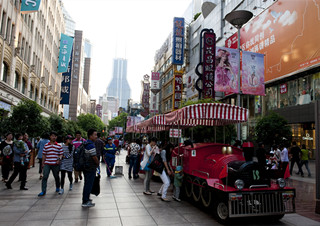- 86-15907880780
- contact@youngchinatravel.com
Nanjing Lu, a so-called "metropolis of foreign adventurers"  and a microcosm of Shanghai's 100 years of development, has once again become one of the great symbols of Shanghai. Beginning in the east at the Bund, Nanjing Lu stretches as far west as Jingan Si. While its eastern section has been separated off and dressed up into a promenade, the rest of Nanjing Lu remains undivided in its original natural state.
and a microcosm of Shanghai's 100 years of development, has once again become one of the great symbols of Shanghai. Beginning in the east at the Bund, Nanjing Lu stretches as far west as Jingan Si. While its eastern section has been separated off and dressed up into a promenade, the rest of Nanjing Lu remains undivided in its original natural state.
150 years ago, a horse racing track was established near the area occupied by the Lihua Department Store, and a small road was built to link up the track with the Bund. This humble precursor to Nanjing Lu — officially named Park Lane — was called "horse road" by the local Chinese residents because of the westerners on horseback they would frequently see riding up and down the road. In those days, Park Road only ran between the Bund and today's Henan Lu, but because of its proximity to the race track, the street attracted network of service and entertainment businesses. In 1862, the foreign concession's governing body extended the road west across the border of the concession (today's Xizang Zhonglu) to Jingan Si in order to help the foreign troops conveniently reach the frontlines of the Taiping Army. This new section of road was named Bubbling Well Road after the famous fountain in front of the Jingan Si Temple. Later, the road's name changed to Jinan Si Road.
As the road continued its expansion westward, at the end of 1865, the western colonials formally renamed it Nanjing Lu. Shops and small businesses rapidly sprouted up along both sides of the road, creating a flourishing strip of land across this developing city. Nanjing Lu gradually established itself as the birthplace of modern commerce in Shanghai. When you hear local people speak of the Big Horse Road or the prosperous and commercial Nanjing Lu, they are generally referring to the eastern section of Nanjing Lu.
By the 1930's, word of this "metropolis of foreign adventurers" became well known in China and abroad. Four of China's largest and most modem early twentieth century markets, Xianshi (a garment company), Yongan (today's Hualian Commercial Building), Xinxin (a food company), and Daxin (Zhongbai Yidian) all located on Nanjing Lu, were able to continue their thriving operations well after the Chinese civil war. To this day you can still find a number of traditional 100 yearold stores on Nanjing Lu — Pengjie Fashions, Pei Luomeng Western Clothing, Wang Kai Photography, Guan Long Photographic Equipment, Shao Wansheng Southern Chinese Goods Store, Zhang Xiaoquan Knife and Scissor store, Wu Liangcai Glasses, Duoyun Xuan, and Heng Deli Watchmaker, to name a few. Here you can also find such venerable yet striking buildings as the old Fuli Company Building (today's Jeanswest Store), Yongan Department Store, and the Peace Hotel.
Nanjing Donglu's popular bustling 
Special Note
The Nanjing Lu Promenade stretches from Xizang Lu to Henan Zhonglu. The Shanghai NO.1 Department Store, Hualian Commercial building, the New World Mall, Yongan Department Store, and Shanghai Landmark Plaza can all be found on this street. Walking down to the street's eastern end will take you to the Peace Hotel and the Bund. Most of the stores on the promenade sell casual clothing suitable for young shoppers. If you can make it here during the between season sales, you should be able to find some great deals.
The promenade also has a tourist tram that runs between 8 am and 10:30 pm. Tickets cost only 5 RMB a piece, but all in all, it is probably more convenient for you to walk.
Upscale malls on the opposite end of Nanjing Xilu include Westgate Mall, CITIC Square, and Plaza 66, which sell high-end name brand goods. You get here by taking the subway's number two line to the Henan Zhonglu or People's Square Stations or on bus lines 20 and 37.